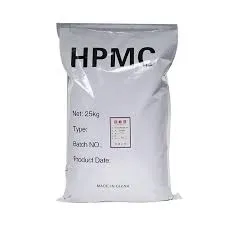
ნოე . 19, 2024 17:18 Back to list
hpmc polymer
Understanding HPMC Polymer Properties, Applications, and Benefits
Hydroxypropyl Methylcellulose (HPMC) is a versatile polymer derived from cellulose, a natural polymer sourced from plant cell walls. It has gained immense popularity in various industries due to its unique characteristics, such as water solubility, non-toxicity, and excellent film-forming abilities. This article explores the properties, applications, and benefits of HPMC, emphasizing its significance in today’s technological landscape.
Properties of HPMC
HPMC is classified as a non-ionic cellulose ether, distinguished by its ability to dissolve in cold water. Its molecular structure includes hydroxypropyl and methyl groups, which enhances its solubility and functional properties. One of the most notable characteristics of HPMC is its viscosity, which can be manipulated by varying the degree of substitution of hydroxypropyl and methyl groups. This property allows it to act as a thickening agent, stabilizer, or emulsifier, making it suitable for diverse applications.
Moreover, HPMC exhibits excellent thermal stability, making it suitable for use in high-temperature processes. It is also resistant to acids and bases, ensuring its stability in various pH conditions. Importantly, HPMC is biodegradable and non-toxic, making it an environmentally friendly choice in comparison to many synthetic additives.
Applications of HPMC
Due to its multifaceted properties, HPMC has found applications across multiple sectors
1. Pharmaceutical Industry HPMC is widely used as a binder, filler, and disintegrant in tablet formulation. It serves as an effective controlled-release agent, helping to prolong the active ingredient's release in the human body. Additionally, HPMC is utilized in eye drops and gels due to its ability to retain moisture and provide a soothing effect.
2. Food Industry In the food sector, HPMC acts as a food additive that enhances texture, stability, and shelf-life. It is commonly found in gluten-free and low-calorie products, where it helps improve the binding and texture without adding significant calories.
hpmc polymer

3. Construction and Building Materials In construction, HPMC is used as a thickener and water-retaining agent in cement-based products such as tile adhesives, mortars, and plaster. Its water-retention properties ensure proper curing of the materials and improve workability.
4. Cosmetics and Personal Care HPMC is used in cosmetic formulations, including shampoos, lotions, and creams, to enhance consistency and provide a smooth texture. Its film-forming ability helps create a protective barrier on the skin, making it a popular ingredient in various skin-care products.
5. Agriculture In agriculture, HPMC is employed in the development of controlled-release fertilizers and pesticides. Its release properties help in the gradual absorption of nutrients, improving the efficiency of fertilizers.
Benefits of Using HPMC
The usage of HPMC comes with several advantages. Firstly, its versatility allows it to serve multiple functions across various industries, reducing the need for numerous additive types. Secondly, its environmentally benign nature aligns with the growing demand for sustainable and eco-friendly products. The use of HPMC reduces the dependency on synthetic materials, thus minimizing potential environmental hazards.
Furthermore, HPMC's contribution to health and safety cannot be understated. In pharmaceutical and food applications, its non-toxic nature makes it a safe choice for consumers. Moreover, its ability to improve product stability and longevity is beneficial to manufacturers and consumers alike.
Conclusion
In conclusion, Hydroxypropyl Methylcellulose (HPMC) is a remarkable polymer that demonstrates diverse properties and extensive applications across numerous industries. Its combination of functionality, environmental compatibility, and safety makes it an essential ingredient in modern formulations. As industries continue to innovate and adopt more sustainable practices, HPMC is likely to play a significant role in shaping the future of product development across pharmaceuticals, food, construction, cosmetics, and agriculture. Understanding and leveraging the potential of HPMC can lead to substantial advancements in creating effective, safe, and sustainable solutions for a variety of applications.
-
Versatile Hpmc Uses in Different Industries
NewsJun.19,2025
-
Redispersible Powder's Role in Enhancing Durability of Construction Products
NewsJun.19,2025
-
Hydroxyethyl Cellulose Applications Driving Green Industrial Processes
NewsJun.19,2025
-
Exploring Different Redispersible Polymer Powder
NewsJun.19,2025
-
Choosing the Right Mortar Bonding Agent
NewsJun.19,2025
-
Applications and Significance of China Hpmc in Modern Industries
NewsJun.19,2025







